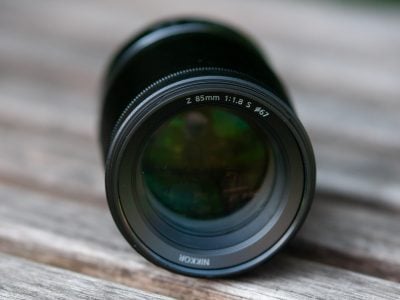Nikon Z 85mm f1.8 S review
-
-
Written by Thomas
Quality
Testing: Longitudinal Chromatic Aberration and focus shift
Lenses with focal ratios of f2.8 or larger are often prone to longitudinal color aberrations (loCA, a.k.a. “axial color” or “bokeh CA”). These show up as magenta coloration in the foreground and greenish hues in the background and are not easily corrected in post-processing. The new Nikon fortunately only shows very little loCA from f1.8 to f2.8 which is comparable to the very good Zeiss Otus.
Nikon Z 85mm f1.8 S Longitudinal Chromatic Aberration (loCA)
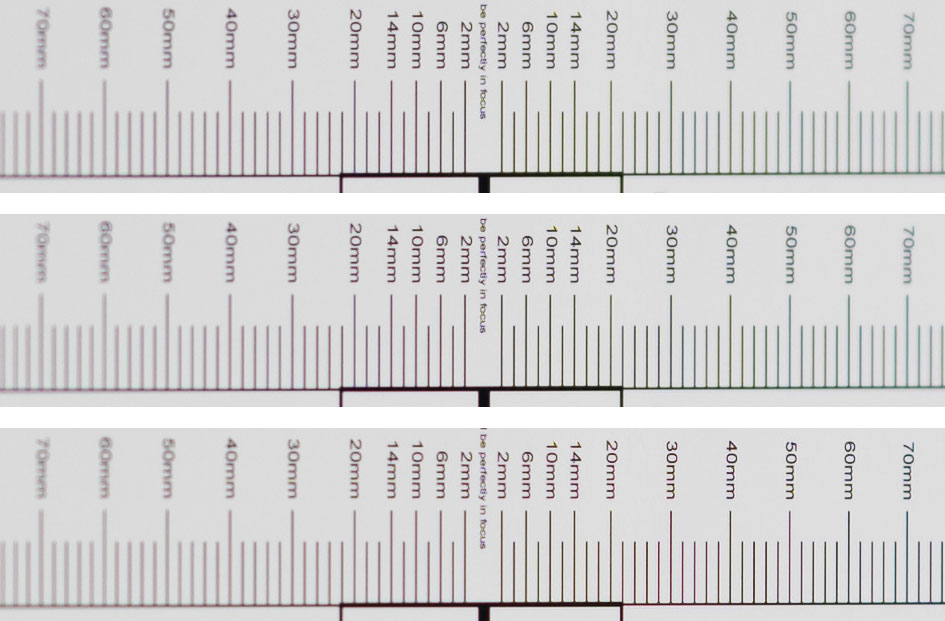
100% crops, from top to bottom: f1.8, f2.0, f2.8; left = foreground, right = background
The test also revealed that there is a slight focus shift: See e. g. how the 40mm mark on the left side becomes slightly more blurred when the lens is stopped down. But I wouldn’t worry about that as the camera normally focuses while stopped down to shooting aperture. For comparison have a look at the Nikon 85mm f1.8G, Nikon 85mm f1.4G, Sigma 85mm f1.4 Art, and the Zeiss Otus 85mm f1.4. All f1.4 lenses are shown at f1.4/f2.0/f2.8.
The following real life shot shows that the new Z Nikkor produces no purple fringing (magenta haloing around high-contrast edges in the focal plane) and only a very weak green outline around background subjects:

Above: Nikon Z 85mm f1.8 S at f1.8; 100% crop; click image to access 4k version
The image of the fountain at the end of the samples page is also testament to what little fringing or loCA the lens produces. Excellent!
Sharpness and contrast
Let’s have a look at the theoretical performance of the new Nikon Z 85mm f1.8 S and compare it to the performance of the Nikon 85mm f1.8G, Zeiss Otus 85mm f1.4 and Sigma 85mm f1.4 Art:
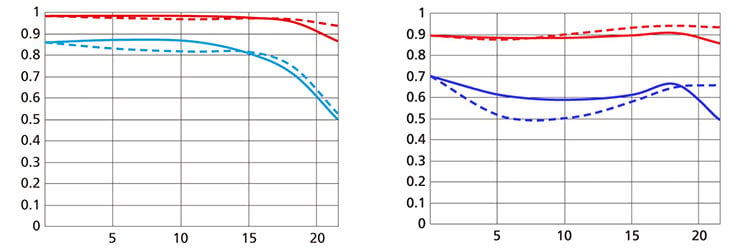
Above: MTF Nikon Z 85mm f1.8 S (left), Nikon 85mm f1.8G (right) at f1.8
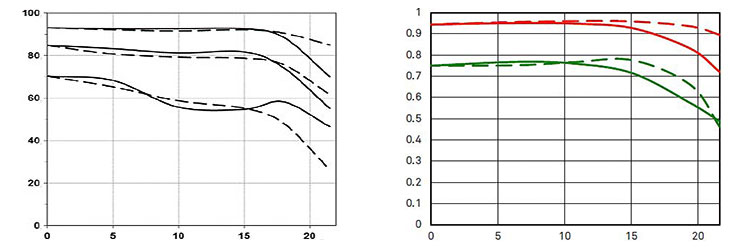
Above: MTF Zeiss Otus 85mm f1.4 (left), Sigma 85mm f1.4 Art (right) at f1.4
These MTF charts of the Nikon and Sigma lenses show the computed lens-performance wide open without influence of diffraction. Higher values are better (more contrast) and the closer the line-pairs are together the less astigmatism (= resolution depends on the orientation of the test-pattern) the lens has. The x-axis displays the distance from the optical axis (=center of the sensor) in mm. I’ll show you the real-life performance at 4 mm (center), 13 mm (APS-C/DX-corner), and 20 mm (FF/FX-corner) on a 45MP Nikon Z7 body. While Nikon and Sigma displays the contrast-curves at 10 line-pairs/mm (in red) and 30 lp/mm (in blue) Zeiss displays the measured contrast-curve (which includes the effects from diffraction) at 10, 20 and 40 lp/mm (from top to bottom), which is a bit unusual.
From the charts the new Nikon Z 85mm f1.8 S should have a clear advantage over the older Nikon 85mm f1.8G. The new Z Nikkor even looks as good as the Zeiss Otus and Sigma Art but keep in mind that the Nikon is at f1.8 here.
Let’s see how this theoretical performance of Nikon’s new Z Nikkor translates into real life results in the sharpness test based on Siemens-stars. Processing was done in Lightroom 8/CRAW 11 from RAW to Adobe Color profile with the built-in lens profile applied. Noise-reduction is set to 0, sharpening to 50/0.5/36/10, with no extra tone, color, or saturation adjustment. White-balance was adjusted to a neutral white and I did some exposure compensation to make the brightness of all crops match. So you will not see light fall-off in the corners. Removal of lateral color aberrations is ON, longitudinal CA are not corrected.
The following 100% crops show the new Nikon Z 85mm f1.8 S compared to the Nikon 85mm f1.8G and the Zeiss Otus 85mm f1.4 at f1.8 all shot under identical conditions on a Nikon Z7. The Sigma 85/1.4 Art and the Nikon 85mm f1.4G were shot on a 36MP Nikon D810/D800 and developed the same except for an adjustment in sharpening. As linear resolution of the 45MP Z7 sensor is 12% higher than from the 36MP sensor the older test shots were a little less demanding than the new ones. No lens profiles were applied except for the new Nikon Z 85mm f1.8 S.
Nikon Z 85mm f1.8 S; 100% crop from center, APS-C/DX-corner, FF/FX-corner

Above: Nikon Z 85mm f1.8 S at f1.8

Above: Nikon 85mm f1.8G at f1.8; also available at f2.0, f2.8, f4.0, f5.6, f8.0, f11

Above: Zeiss Otus 85mm f1.4 at f1.8; also available at f1.4, f2.0, f2.8, f4.0, f5.6, f8.0, f11

Above: Sigma 85mm f1.4 Art shot on a 36MP Nikon D810 at f1.8; also available at f1.4, f2.0, f2.8, f4.0, f5.6, f8.0, f11

Above: Nikon 85mm f1.4G shot on a 36MP Nikon D800 at f1.8; also available at f1.4
At f1.8 the Nikon Z 85mm f1.8 S produces sharper results than the Nikon 85mm f1.8G across the full-frame sensor. It even holds it own against the reference Otus lens with a slightly sharper DX-corner and a bit more contrast in the FX-corner. The Sigma 85mm f1.4 Art shows the best FX-corner but keep in mind that it was shot on a less demanding 36MP Nikon D810. The older Nikon 85mm f1.4G is the softest of the bunch. The new Z Nikkor shows practically no field-curvature at this distance like the exemplary Zeiss Otus. Very Good!
Now let’s see how the new Z Nikkor develops when stopped down:

Above: Nikon Z 85mm f1.8 S at f2.0

Above: Nikon Z 85mm f1.8 S at f2.8

Above: Nikon Z 85mm f1.8 S at f4.0

Above: Nikon Z 85mm f1.8 S at f5.6

Above: Nikon Z 85mm f1.8 S at f8.0

Above: Nikon Z 85mm f1.8 S at f11
The FX-corner has sharpened up nicely at f4.0 and from f11 onward you can clearly see softening from diffraction. Overall Nikon’s new Z 85mm f1.8 S lens proves its merit in this test against my reference lens in this class, the Zeiss Otus 85mm f1.4.
Performance at long distances
The Siemens-star test-targets are shot at a distance of 45x focal length (i.e. at around 4m for 85mm focal length). But performance of lenses also depends on the shooting distance. Therefore I present another series of test-shots of a city around 1 km away. Processing was done in Lightroom 8/CRAW 11 from RAW to Adobe Color profile with the lens-profile for distortion applied, vignette control was off. Noise-reduction is set to 0, sharpening to 50/0.5/36/10, with no extra tone, color, or saturation adjustment. I used manual focus at the largest aperture and did not change focus for other apertures. All shots were made at ISO 64 and VR switched off.
The main image shows the complete scene wide open to give you an impression of the angle of view and to judge vignetting. You can access the respective shots up to f11 via the links beneath the main image. Following the main image are 100% crops from the new Nikon Z 85mm f1.8 S compared to the Nikon 85mm f1.8G shot only minutes apart. The Zeiss Otus 85mm f1.4, Sigma 85/1.4 Art, and Nikon 85mm f1.4G were shot at other days with roughly comparable atmospheric conditions. Please respect our copyright and only use those images for personal use.
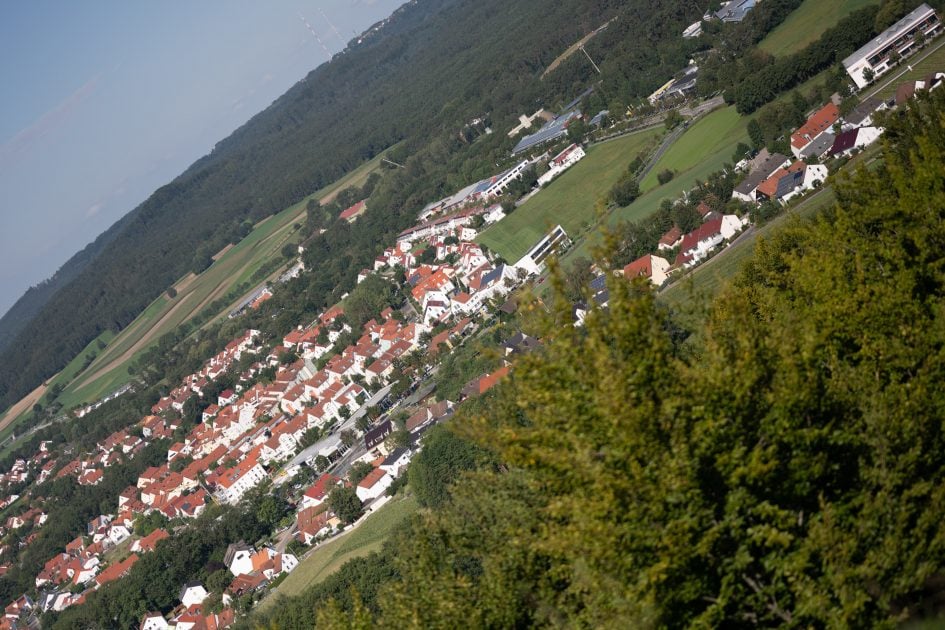
Above: Nikon Z 85mm f1.8 S at f1.8; click image for 4k version, also available as large original at f1.8, f2.0, f2.8, f4.0, f5.6, f8.0, f11

Above: Nikon Z 85mm f1.8 S at f1.8; 100% crop from center, DX-corner, FX-corner

Above: Nikon 85mm f1.8G at f1.8; click image for 4k version, also available as large original at f1.8, f2.0, f2.8, f4.0, f5.6, f8.0, f11

Above: Zeiss Otus 85mm f1.4 at f1.8; click image for 4k version, also available as large original at f1.4, f1.8, f2.0, f2.8, f4.0, f5.6, f8.0, f11

Above: Sigma 85mm f1.4 Art shot on a 36MP Nikon D810 at f1.8; click image for 4k version, also available as large original at f1.4, f1.8, f2.0, f2.8, f4.0, f5.6, f8.0, f11, f16

Above: Nikon 85mm f1.4G shot on a 36MP Nikon D800 at f1.8; click image for 4k version, also available as large original at f1.4, f1.8, f2.0, f2.8, f4.0, f5.6, f8.0, f11
The Nikon Z 85mm f1.8 S looks again very similar to the Zeiss Otus even down to the meridional spikes around the letters of “saunapark” in the FX-corner. The Nikon 85mm f1.8G shows how the FX-corner should look like. But unfortunately it renders a softer DX-corner and suffers from magenta haloing in the center. The Sigma Art looks pretty good on a 36MP sensor and the Nikon 85mm f1.4G is again the softest in this comparison.
Let’s see how the new Z Nikkor develops when stopped down:

Above: Nikon Z 85mm f1.8 S at f2.0

Above: Nikon Z 85mm f1.8 S at f2.8

Above: Nikon Z 85mm f1.8 S at f4.0

Above: Nikon Z 85mm f1.8 S at f5.6

Above: Nikon Z 85mm f1.8 S at f8.0

Above: Nikon Z 85mm f1.8 S at f11
The FX-corner on the Nikon Z 85mm f1.8 S obviously is the soft spot of the new lens, literally: it stays a bit blurry until stopped down to f8.0. Keep in mind though that we’re looking at a 100% crop of the extreme corner on a 45MP full-frame sensor. Have a look at the full images to see that the lens stays very sharp up to 17-18mm image height.
Rendering of point-light sources at night-shots
Night-shots pose a different challenge for lenses as the contrast is even higher than under bright sun and point-light sources can reveal some weaknesses such as coma, haloing and colour-aberrations that do not show up as prominently in other test-shots. The 100% crops below the main image show the effect of coma in the FF/FX-corner of the new Z Nikkor and the Zeiss Otus 85mm f1.4 at various apertures:
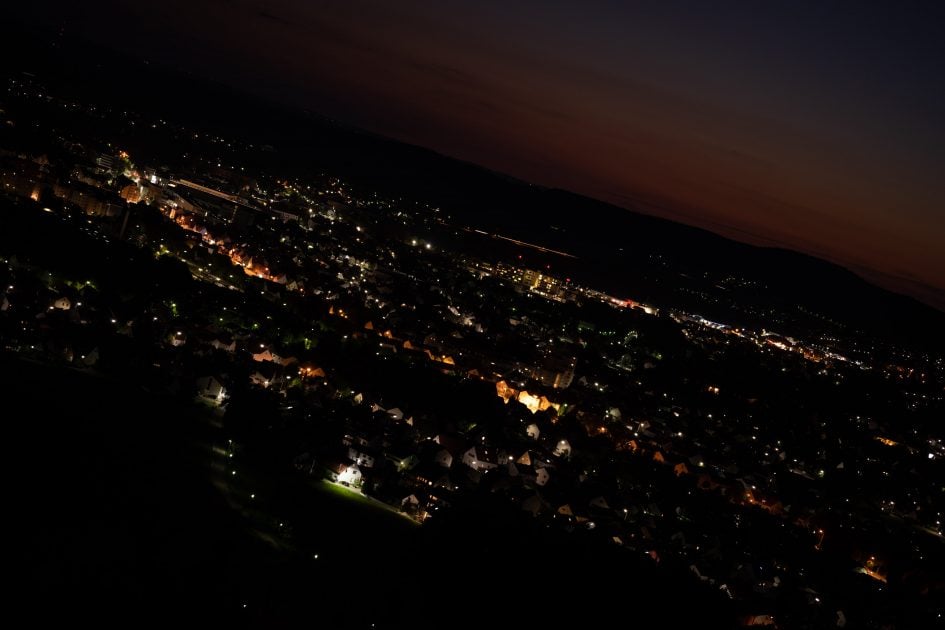
Above: Nikon Z 85mm f1.8 S at f1.8; click image for 4k version, also available as large original at f1.8, f2.0, f2.8, f4.0, f5.6, f8.0

Above: Nikon Z 85mm f1.8 S; 100% crops from the FX-corner at f1.8 (left), f2.0 (middle), f2.8 (right)

Above: Nikon 85mm f1.8G; 100% crops from the FX-corner at f1.8 (left), f2.0 (middle), f2.8 (right)

Above: Zeiss Otus 85mm f1.4; 100% crops from the FX-corner at f1.4 (left), f2.0 (middle), f2.8 (right)

Above: Sigma 85mm f1.4 Art; 100% crops from the FX-corner at f1.4 (left), f2.0 (middle), f2.8 (right)

Above: Nikon 85mm f1.4G; 100% crops from the FX-corner at f1.4 (left), f2.0 (middle), f2.8 (right)
The new Nikon Z 85mm f1.8 S has only little coma wide open similar to the Nikon 85mm f1.8G and the Sigma Art. The Zeiss Otus 85mm f1.4 and the Nikon 85mm f1.4G both produce stronger coma.
Rendering of out-of-focus point-light sources
This test is for the rendering of point-light sources in an out-of-focus background. The circle of confusion that is produced by this test is pretty indicative of Bokeh performance (in the background) and light fall-off. Ideally the out-of-focus image of the point-light is evenly lit and perfectly circular, with no “onion-rings”, and without coloration. Large aperture lenses normally produce an effect known as “cat’s eye” the further away from the optical axis the point-light is projected. This is due to optical vignetting in the lens barrel when light enters the lens from an angle.
The new Z Nikkor is first, followed by the usual batch of comparisons.
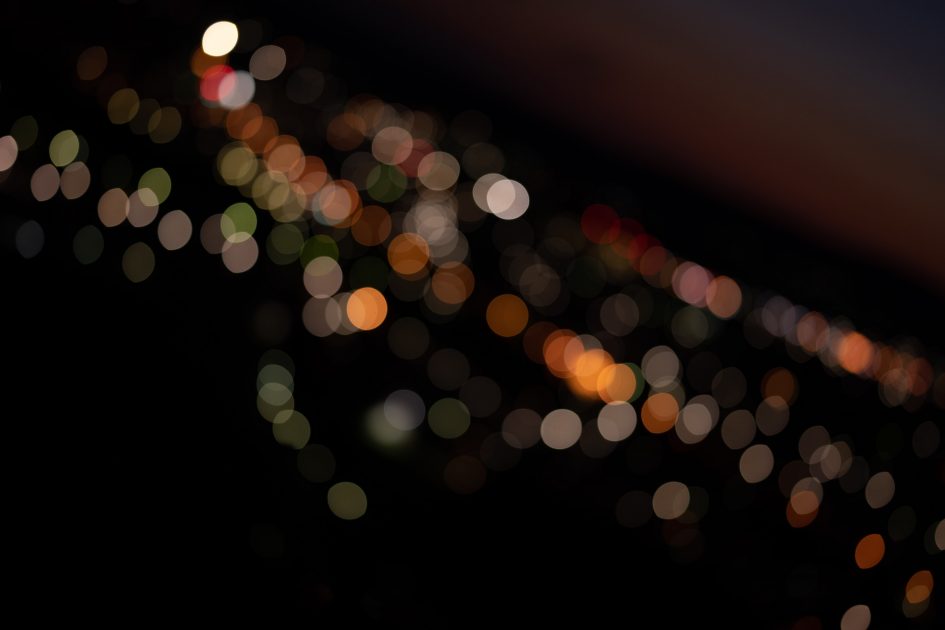
Above: Nikon Z 85mm f1.8 S at f1.8; click image for 4k version, also available as large original at f1.8, f2.0, f2.8, f4.0, f5.6, f8.0

Above: Nikon Z 85mm f1.8 S at f1.8; 44% crops from center, DX-corner, FX-corner

Above: Nikon 85mm f1.8G at f1.8; 44% crops from center, DX-corner, FX-corner; click image for 4k version, also available as large original at f1.8, f2.0, f2.8, f4.0, f5.6, f8.0

Above: Zeiss Otus 85mm f1.4 on a 36MP Nikon D810 at f1.4; 44% crops from center, DX-corner, FX-corner; click image for 4k version, also available as large original at f1.4, f1.8, f2.0, f2.8, f4.0, f5.6, f8.0

Above: Sigma 85mm f1.4 Art on a 36MP Nikon D810 at f1.4; 50% crops from center, DX-corner, FX-corner; click image for 4k version, also available as large original at f1.4, f1.8, f2.0, f2.8, f4.0, f5.6, f8.0

Above: Nikon 85mm f1.4G on a 36MP Nikon D800 at f1.4; 50% crops from center, DX-corner, FX-corner; click image for 4k version, also available as large original at f1.4, f2.0, f2.8, f4.0, f5.6
The diameter of the Bokeh balls in the center is determined by the entrance pupil of the lens. So the f1.8 lenses produce Bokeh balls that are roughly 25% smaller than from their f1.4 brethren. But other than that the new Z Nikkor looks pretty good: there is only little outlining, the texture within the circle is smooth and the cat’s eye effect moderate. The Nikon 85mm f1.8G is pretty similar but shows some green outlining from loCA. The Zeiss Otus shows some moderate onion rings and some clipping from the mirror box which is no surprise as that shot was taken on a Nikon D810. Same for the Sigma Art and the Nikon 85mm f1.4G. Bokeh balls of all lenses are already slightly compressed at the DX-corner where the Sigma Art retains the largest Bokeh balls.
Now let’s see how this analysis of out-of-focus point-light sources translates into Bokeh-performance shooting a book-shelf.
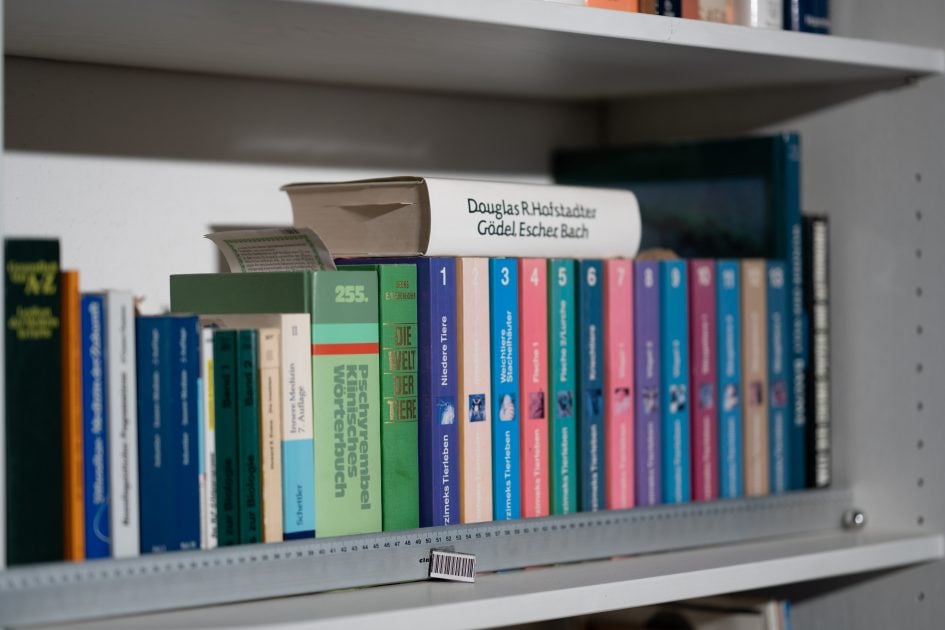
Above: Nikon Z 85mm f1.8 S at f1.8; click image for 4k version, also available as large original at f1.8, f2.0, f2.8, f4.0, f5.6, f8.0

Above: Nikon Z 85mm f1.8 S at f1.8; 44% crops from foreground, middle-ground, background

Above: Nikon 85mm f1.8G at f1.8; 44% crops from foreground, middle-ground, background; click image for 4k version, also available as large original at f1.8, f2.0, f2.8, f4.0, f5.6, f8.0

Above: Zeiss Otus 85mm f1.4 at f1.4; 44% crops from foreground, middle-ground, background; click image for 4k version, also available as large original at f1.4, f1.8, f2.0, f2.8, f4.0, f5.6, f8.0

Above: Sigma 85mm f1.4 Art on a 36MP Nikon D810 at f1.4; 50% crops from foreground, middle-ground, background; click image for 4k version, also available as large original at f1.4, f1.8, f2.0, f2.8, f4.0, f5.6, f8.0
The best Bokeh is produced by the Sigma Art with both the Z Nikkor and the Zeiss Otus coming in 2nd place. Which is interesting as the Otus was shot at f1.4. But it has the slightly harsher rendering in the middle- and background. The Nikon 85mm f1.8G comes last with green/magenta coloration in the middle ground and some nervous background.
Portrait performance
85mm focal length is the classical choice for portraits on a full-frame camera for upper body or full body shots. All shots were done from the same position/distance so perspective does not change between shots. There is slightly different framing from different effective focal length at the shooting distances and there are also some slight focus-differences which inevitably occur when you shoot a living, breathing subject. All images were developed from RAW to Adobe Color profile with identical white balance.
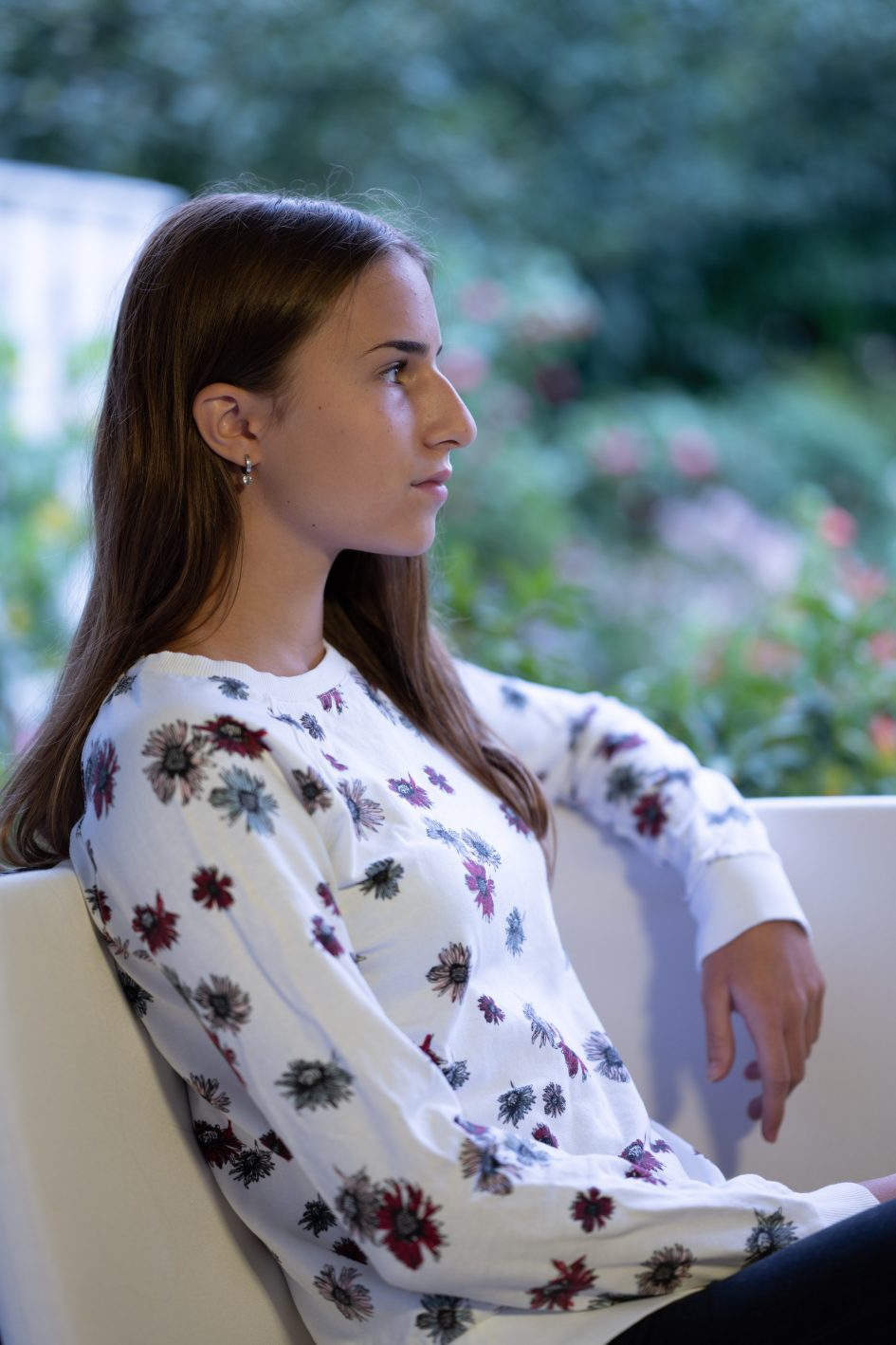
Above: Nikon Z 85mm f1.8 S at f1.8; click image for 4k version, also available as large original at f1.8, f2.0, f2.8, f4.0

Above: Nikon Z 85mm f1.8 S at f1.8, 50% crop; click image to view 100% crop

Above: Nikon 85mm f1.8G at f1.8, 50% crop; click image to view 100% crop, also available as large original at f1.8, f2.0, f2.8, f4.0

Above: Zeiss Otus 85mm f1.4 at f1.4, 50% crop; click image to view 100% crop, also available as large original at f1.4, f1.8, f2.0, f2.8, f4.0
Flare, glare, ghosting, and sun-stars
Catching a strong light-source shining directly into the lens is always a risky business: it could produce strange colorful ghost-images or reduce contrast considerably through flare and glare. The appearance of flare and ghosting depends on factors like the aperture and the angle of the light hitting the lens. So to judge the proclivity of the new Nikon Z 85mm f1.8 S for these artifacts I went through a series of well calculated shots against a strong light source to provoke glare and ghosting. The lens hood was mounted in all shots. Following are two of the more extreme example results. The little bright square inset in the upper left shows the respective area with an exposure compensation of +3 EV to make it easier to see which levels of black the lens renders at that point:
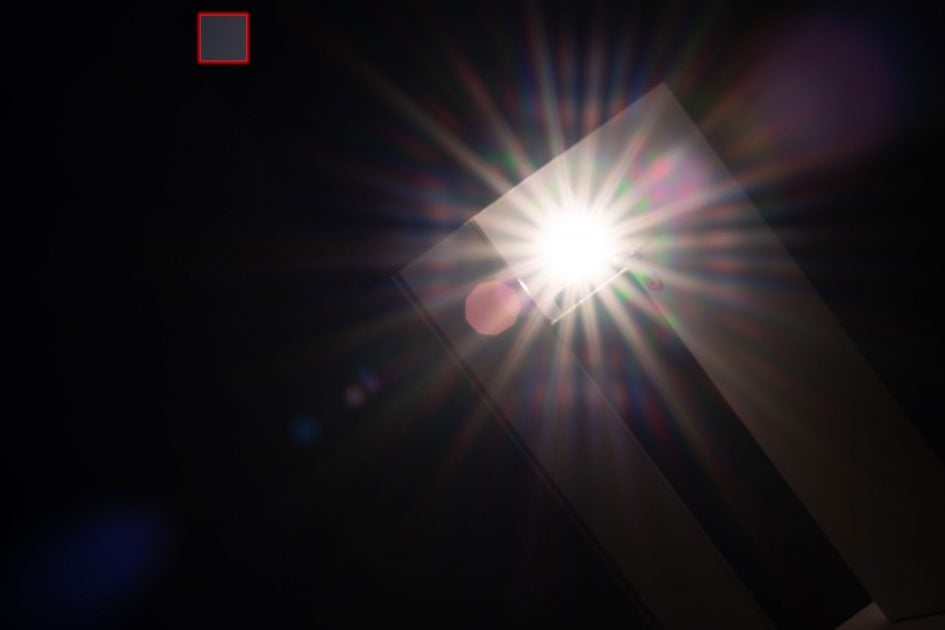
Above: Flare and ghosting. Strong light hitting the Nikon Z 85mm f1.8 S at f11; click image for 4k version or here for +3 EV exposure compensation
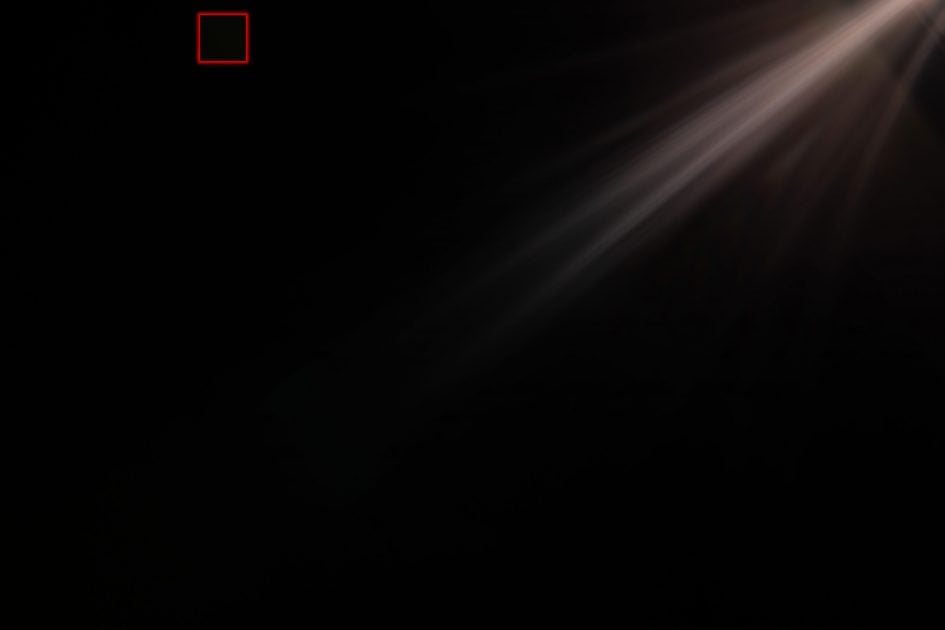
Above: Flare and ghosting. Strong light hitting the Nikon Z 85mm f1.8 S at f11; click image for 4k version or here for +3 EV exposure compensation
Flare and ghosting is pretty well controlled as is glare. The flare from the upper right in the second image only occurs at a very narrow angle when the light-source is just outside the corner. For comparison have a look at the Nikon 85mm f1.8G here and here.
The new Nikon Z 85mm f1.8 S produce well defined sunstars already at f4. And the more you stop down the bigger they get:

Above: Sunstars from the Nikon Z 85mm f1.8 S at f4.0, f5.6, f8.0, 100% crops
Next check out my sample images!
Check prices on the Nikon Z 85mm f1.8 S at B&H, Adorama or WEX. Alternatively get yourself a copy of my In Camera book or treat me to a coffee! Thanks!



